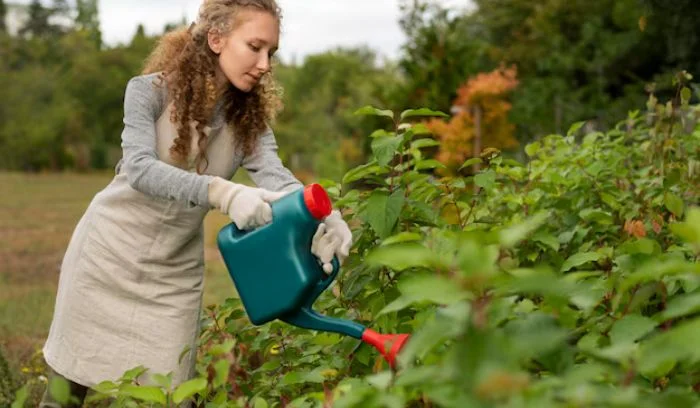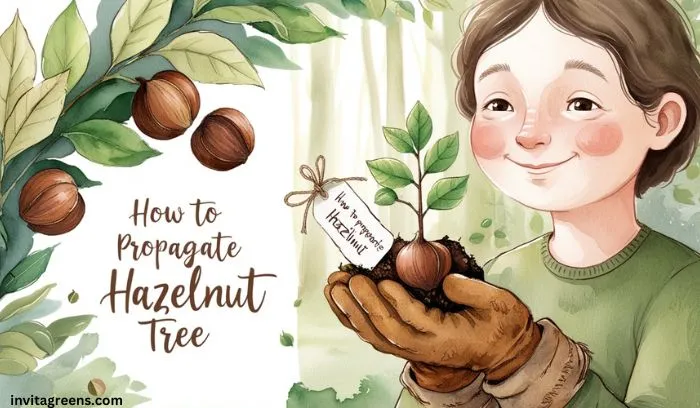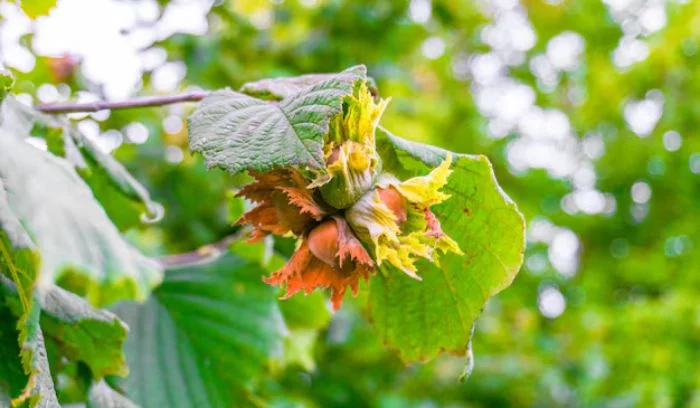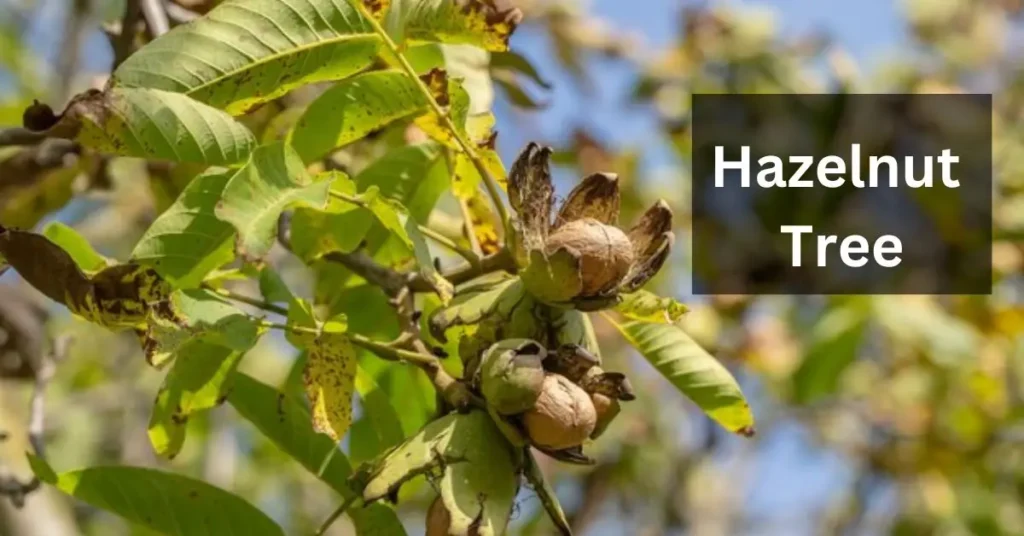The European hazelnut is a well-known source of hazelnuts, also called filberts, which are popular for their delicious taste and rich nutritional value. This moderately fast-growing tree or shrub has a multi-trunked structure and a suckering growth habit, making it a great choice for gardens with a bit of space.
In the late winter to early spring, the plant starts its blooming process. During this time, male flowers in the form of catkins and inconspicuous female flowers emerge at different times on the same plant. For pollination to occur, it’s essential to have at least two varieties of hazelnuts planted close together.
Once the nuts ripen, which happens in late August to September, the plant reaches its peak. If you’re planning to add a hazelnut tree to your garden, the best time to plant it is during its dormancy period, ideally in the late winter or early spring.
With their ornamental value and rich harvest, hazelnut trees make a beautiful and functional addition to any landscape. They are easy to grow, and with the right care, they can thrive for many years.
Basic
| #- | Attribute | Details |
|---|---|---|
| 1- | Common Name | Hazelnut Tree |
| 2- | Botanical Name | Corylus |
| 3- | Family | Betulaceae |
| 4- | Plant Type | Deciduous Tree |
| 5- | Hardiness Zones | 4-9 (USDA) |
| 6- | Sun Exposure | Full sun, Partial shade |
| 7- | Soil Type | Well-drained, Loamy soil |
| 8- | Soil pH | 6.0-7.5 (Slightly acidic to slightly alkaline) |
| 9- | Maturity | 3-5 years |
| 10- | Height | 15-20 feet |
| 11- | Spacing | 10-15 feet apart |
| 12- | Bloom Time | Late winter, Early spring |
| 13- | Flowers | Male, Female |
| 14- | Flower Color | Yellowish-green (Catkins) |
| 15- | Native Area | Europe, Asia, North America |
Hazelnut Tree Plant Care
Caring for hazelnut trees requires a careful balance of attention to their specific needs. To achieve optimal growth and ensure a bountiful harvest of hazelnuts, start by choosing a suitable planting site with well-draining soil. A loamy, slightly acidic, or alkaline soil works best for these deciduous trees.

Plant your hazelnut tree in a location that gets full sun to partial shade so it can receive the right amount of sunlight throughout the day. During dry spells, ensure consistent moisture while avoiding waterlogged soil. Applying mulch around the base of the tree aids in moisture retention and suppresses weed growth.
To maintain a healthy tree, pruning is essential. Regularly prune in late winter or early spring while the tree is dormant to help maintain its shape and improve air circulation within the branches. Remove diseased branches or damaged branches to prevent disease and promote overall tree health.
In addition, fertilize your hazelnut trees with a balanced fertilizer to provide essential nutrients for robust growth. Keep an eye out for common pests like aphids and caterpillars, and encourage natural predators like ladybugs to help control them. Regular leaf inspection can help you spot early disease signs, ensuring timely treatment. With proper care, you’ll enjoy healthy, delicious, and nutritious nuts year after year.
Light
One of the most fundamental factors influencing the health and growth of hazelnut trees is light. These trees thrive in locations that receive full sun, but they can also adapt to partial shade.
If you have the right spot with ample sunlight, your hazelnut trees will experience vigorous growth and produce an abundant nut production. Full sun exposure is particularly beneficial, as it encourages strong, healthy trees with rich foliage.
That being said, hazelnut trees can tolerate some filtered sunlight in areas with intense heat, although their growth may be slightly slower. In such conditions, they can still flourish and produce robust foliage and healthy hazelnuts. Providing the right amount of light is essential for cultivating these remarkable trees, ensuring they grow well and bear fruit in the long term.
Soil
When caring for hazelnut trees, one of the most fundamental aspects to consider is meeting their specific soil requirements. These trees thrive in well-drained, loamy soil with a good balance of moisture retention and drainage mix.
It’s important to avoid compacted or waterlogged soil, as these conditions can hamper their growth and affect overall tree health. For the best results, hazelnut trees prefer a soil that is slightly acidic to slightly alkaline, with a soil pH range between 6.0 and 7.5.
Regular testing and amending the soil if necessary will have a significant impact on the tree’s overall health and productivity. Proper soil conditions create a solid foundation, enabling the tree to flourish, bear a bountiful harvest of nutritious nuts, and grow strong year after year.
Water
Hazelnut trees require regular irrigation to flourish properly. In the initial years, young trees need consistent moisture to establish strong roots. They should be watered regularly, ensuring the soil remains damp but not waterlogged.

A good strategy is deep watering to allow the moisture to reach the root system, promoting healthy development. For established hazelnut trees, moderate drought tolerance allows them to withstand dry conditions, but they still need adequate hydration during dry spells.
To maintain optimal health, regular monitoring of the moisture levels in the soil is important. Adjusting the watering frequency based on weather conditions helps keep the trees thriving.
Adding mulching around the base of the tree helps retain moisture and regulate water uptake, reducing the need for frequent watering. A well-balanced watering schedule ensures the overall health and productivity of your hazelnut trees throughout the seasons.
Temperature and Humidity
Caring for hazelnut trees requires understanding their natural ability to be resilient and adaptable to different climates. These trees thrive in temperate climates, benefiting from cool winters and mild summers that offer ideal conditions for growth.
They perform best in hardiness zones 4 to 9, showcasing their ability to withstand degrees of cold temperatures while needing sufficient winter chill to encourage proper fruiting. I’ve noticed that in my own experience, balancing these conditions can transform your garden into a bountiful harvest of delicious nuts.
Ensuring the Right Humidity and Moisture
Managing humidity is just as crucial as regulating temperature. Hazelnut trees can tolerate various levels of moisture, making them suitable for different regions. However, during dry spells, it’s essential to provide adequate moisture to ensure healthy growth.
A layer of mulching around the tree’s base helps retain moisture and maintains a stable environment. From my own efforts, I’ve found that nurturing these trees with a good balance of care allows them to flourish and produce consistent yields year after year.
Fertilizer
Hazelnut trees have specific fertilizer requirements to ensure their optimal growth and produce bountiful nuts. Their nutritional requirements encompass a well-balanced proportion of nitrogen, phosphorus, and potassium (N-P-K).
A slow-release granular fertilizer with a 10-10-10 ratio is recommended as it provides steady nourishment. Applying this fertilizer in early spring, just before the season’s growth begins, is essential to meet the tree’s energy needs and promote its healthy development.
In my experience, a well-fertilized hazelnut tree grows expansive branches, rich foliage, and yields a plentiful harvest of tasty hazelnuts. Proper fertilization care not only enhances the tree’s overall health but also boosts its productivity, creating a thriving environment. Remember, tending to their nutrient needs is a critical step toward ensuring these trees flourish.
Pruning
Pruning is a vital part of hazelnut tree care, ensuring the tree’s health, maintaining its shape, and boosting its productivity. From my experience, pruning is best done in late winter or early spring when the tree is dormant.
This practice helps remove dead or diseased branches, allowing proper airflow and sunlight penetration, which fosters a healthier canopy. By trimming crossed or crowded branches and those growing toward the tree’s center, you can maintain an open, well-ventilated structure that promotes growth.
I always make sure to prune away water sprouts and suckers from the tree’s base to focus its energy on the main branches. Incorporating rejuvenation pruning, where older, less productive wood is removed, stimulates the growth of vigorous branches.
Using sharp, clean tools for precise cuts minimizes damage to the tree while enhancing its appearance and ensuring better nut production. Thoughtful pruning supports a thriving garden and a bountiful hazelnut harvest.
Overwintering
Caring for hazelnut trees during the winter requires careful planning to provide proper protection against freezing temperatures and frost. A thick layer of mulching made from organic material, such as straw or compost, acts as a natural insulator around the tree’s base, shielding the roots from extreme cold.
From my experience, wrapping the trunk with burlap or tree wrap effectively prevents sunscald, a problem caused by sudden temperature fluctuations. Additionally, watering adequately before the ground freezes helps the trees withstand drought stress during colder months.
Regularly inspecting for pests or diseases and quickly addressing issues ensures the trees remain in optimal health. With proper care, the trees are ready to blossom and bear fruits when spring arrives, creating a thriving and productive garden.
Winter Care for Hazelnut Trees
When winter comes, Hazelnut trees need extra attention to survive the harsh conditions. Being part of the birch family, these trees are used to colder climates, especially in the Northern Hemisphere, but they still need protection against frost and cold winds.

To safeguard young trees, covering them with burlap sacks or frost cloths can help shield them from frost damage. For added protection, applying anti-desiccant sprays on the branches can prevent moisture loss. As temperatures drop, roots become vulnerable too, so mulch made of straw or compost around the base of the tree provides crucial insulation.
Windbreaks are another useful strategy. By building a windbreak around your Hazelnut trees, you reduce the damage caused by harsh winds. Wrapping the trunk with tree wrap helps prevent sunscald, a condition where the trunk gets damaged by fluctuating winter temperatures.
Also, don’t forget about fertilizing—avoid feeding your trees within six weeks of the first fall frost to give them time to rest. Kocide and Mancocide mixtures, combined with horticultural oil, can be sprayed on your trees to control pests, bacteria, and fungi, keeping your Hazelnut trees healthy and free from disease.
Types of Hazelnut Tree
Hazelnut trees come in diverse species and cultivated varieties, each with unique characteristics and rich flavors. The European Hazelnut is a widely recognized type, valued for its versatility and delicious taste.
With their adaptability, these species and varieties suit different climates and uses, offering a range of options for gardeners. Their unique characteristics make them a beautiful and rewarding choice for any landscape.
Common Hazel (Corylus avellana)
Corylus avellana, also called Common Hazel, is a cultivated species loved for its flavorful nuts. These medium-sized trees, reaching up to 20 feet in height, produce nuts in a hard shell that are typically harvested in late summer or early autumn.

Known for their sweet and rich taste, these nuts are highly cherished and often a popular choice for culinary uses and confectionery.
From my experience, the tree’s male catkins are a crucial food staple for ruffed grouse during the winter, adding to its ecological value. Its adaptability and ability to thrive in various environments make it a prized addition to any garden, offering both beauty and bounty.
American Hazelnut (Corylus americana)
Corylus americana, also called the American Hazelnut Tree or American Hazel, is a native species to eastern North America. These thicket-forming, shrubby trees grow between 8 to 12 feet tall and produce delicious, round nuts that are encased in a thick, fringed husk.
The nuts are highly valued for their culinary applications and serve as an essential part of wildlife habitats, attracting animals like squirrels, deer, turkey, woodpeckers, pheasants, grouse, quail, and jays.
From my experience, these trees thrive in various soil types and harsh climates, making them a favorite among gardeners and nature enthusiasts. Their adaptability, combined with their beauty, makes them an excellent choice for anyone looking to add a shrub that supports both biodiversity and practical uses in their landscape.
Turkish Hazel (Corylus color)
Corylus colurna, also known as Turkish Hazel, originates from Southeastern Europe and Western Asia. These towering trees, reaching heights of 40 to 60 feet, produce long, slender nuts encased in a thin shell. The nuts have a delightful, sweet flavor and are highly prized in the culinary world, particularly for use in baking and confectionery.
From my experience, the hardy and adaptable nature of Turkish Hazel makes it a favorite among growers in diverse climates. Its beauty, coupled with its versatility, ensures it finds favor not only for its nuts but also as a striking addition to landscapes. This tree’s unique qualities make it an excellent choice for those seeking productivity and elegance in their gardens.
European Hazelnut (Corylus avellana var. pontica)
The European Hazelnut, a specific variety of the Corylus avellana species, is celebrated for its high-quality nuts and long history of cultivation in Europe. These trees produce nuts with a distinct, rich flavor, making them a staple in European cuisine and highly sought-after for both commercial and home use.
These hazelnuts thrive in temperate climates with well-drained soil, ensuring they are a choice option for gardeners and growers. Their adaptability and exceptional quality make them a reliable and versatile addition to nut farming or culinary ventures.
Cultivated Varieties: ‘Barcelona,’ ‘Ennis,’ and ‘Butler’
Among cultivated hazelnut varieties, Barcelona, Ennis, and Butler stand out for their distinct traits tailored to meet the needs of growers. Barcelona hazelnuts are known for their large, flavorful nuts, making them ideal for commercial cultivation.
Ennis hazelnuts offer high yields and strong disease resistance, which is why they are particularly popular in orchards. Meanwhile, Butler hazelnuts are prized for their excellent quality and adaptability, excelling in various soil types.
From my experience, these varieties provide flexible options to suit unique preferences and growing conditions. Their versatility and ability to thrive make them a reliable choice for growers looking for success in hazelnut farming, whether for commercial purposes or personal cultivation.
How to Plant Hazelnut Tree From Seed

Planting a hazelnut tree from seed is a joyful experience. Begin with a small seed, take the right steps, and cultivate it into a thriving tree.. Over the years, this growth creates a magnificent tree to grace your garden.
This simple yet fulfilling process lets you enjoy nature’s beauty while creating a lasting addition to your outdoor space.
Step 1: Preparing the Seed
Selecting a healthy hazelnut seed is the first step toward successful planting. To check its viability, place the seed in a water bowl—if it sinks, it’s ready for the next step. Planting a hazelnut tree from seed is a joyful experience. This aids in promoting germination by allowing moisture to reach the seed.
Once scarified, soak the seed in water for 24 hours to ensure proper hydration, which is vital for its development. This process not only prepares the seed but also ensures it is primed and ready for a thriving planting journey.
Step 2: Planting the Seed
Choose a sunny spot in your garden with well-draining soil to ensure healthy growth. Create a small hole about 2 inches deep and gently place the hazelnut seed inside. Once positioned, cover it gently with soil, making sure it’s snug but not overly compacted.
After planting, water thoroughly to help settle the soil and initiate the germination process. This step ensures that the seed gets the right start and has the conditions it needs to thrive as it begins to grow.
Step 3: Providing the Right Conditions
Hazelnut trees thrive in well-drained, slightly acidic soil, making it important to choose the right spot for planting. Ensure the seedling receives ample sunlight, at least 6 hours a day, to fuel its growth. Regular watering is crucial, especially during dry spells, but be careful to avoid waterlogging, as hazelnuts dislike standing water.
To create a healthy environment, apply mulch around the tree’s base to retain moisture and suppress weeds. These steps help foster a healthy environment and allow the tree to flourish over time, ensuring successful growth and development.
Step 4: Addressing Common Pests and Problems
Stay vigilant for common pests like aphids and caterpillars, which can harm your hazelnut tree. Using a natural insecticidal soap is an effective way to help manage these nuisances without harming the tree. Regular monitoring ensures early detection, which is critical for keeping your tree healthy.
Pruning is essential to remove dead or diseased branches, allowing the tree to channel its energy into healthy growth. This approach keeps your tree strong and fruitful, supporting its growth and vitality over time.
Step 5: Flowering, Fruiting, and Aftercare
With patience, your hazelnut tree will eventually bless you with delicate catkins and clusters of nuts. The blooming period, typically in late winter to early spring, showcases the tree’s beauty at its peaks. After the first year, applying a balanced fertilizer will support the tree’s nutritional needs, helping it remain resilient and allowing it to flourish.
As you nurture your seedling into maturity, consistent care and attention will be key. Watching your tree growing and cultivating in your backyard becomes more than gardening—it’s a living testament to the wonders of nature, bringing a sense of fulfillment and connection.
How to Propagate Hazelnut Tree
Propagating hazelnut trees can be done through three effective methods, and one popular approach is tie-off layering. Start by choosing a suitable, low, flexible branch from the parent tree. Scrape the bark gently to wound it and expose the inner layer, then cover the area with moist soil. Ensure the soil stays consistently damp to encourage the development of roots over time.

Once the branch has grown a strong root system, you can transplant the new tree to a desired location. This method is highly reliable and allows you to successfully propagate hazelnut trees while following unique steps for long-term success.
Propagation through Grafting
To propagate a hazelnut tree using grafting, start by selecting a healthy rootstock and a desired variety as the scion. Carefully choose a sapling with strong growth for the rootstock and a cutting from your preferred hazelnut variety. Make accurate and clean incisions on both the rootstock and scion for a seamless connection.
Once aligned, secure the grafts using grafting tape or rubber bands, ensuring they are tight and stable. Allow the tissues to fuse and heal, which usually takes several weeks. During this time, monitor growth for signs of successful integration, ensuring the process results in a thriving new tree.
Propagation through Cuttings
To propagate a hazelnut tree through cuttings, select healthy branches that are disease-free. Cut stem sections into 6 to 8-inch pieces, ensuring each piece includes multiple leaf nodes. Remove the lower leaves and dip the cut end into a rooting hormone to stimulate root growth effectively.
Plant the prepared cuttings in a well-draining soil mixture, keeping it consistently moist. With regular care, monitor the development of roots and ensure the process remains successful. This method not only supports propagation but also helps expand your collection of homegrown varieties, enhancing the beauty of your garden.
Harvesting and Storing Hazelnuts
Gathering hazelnuts is a rewarding finale to your dedication as a gardener. Proper timing and careful handling are essential to ensure the nuts reach their peak flavor and perfect texture. It’s best to watch for signs that the nuts are ready to fall naturally from the tree, as this indicates they are fully matured and flavorful.
After gathering, focus on storing hazelnuts to maintain their quality. Use the best practices by keeping them in a cool, dry place to preserve their delectable flavor. These treasures from your garden will reward your dedication and allow you to enjoy the fruits of your labor over time.
Harvesting Hazelnuts
Timing the harvest of hazelnuts is key to ensuring their best flavor and quality. The ideal time is when the nuts are mature but haven’t started falling naturally from the tree. Look for visual signs like a golden-brown, slightly wrinkled appearance. For American hazelnuts, this typically occurs over six weeks during September and October.
To collect the nuts, gently shake the branches and use a tarp or cloth to catch the ripe hazelnuts. Handpick remaining nuts and inspect them for maturity. You can also crack a few nuts to check if the kernels are fully developed and plump. Once gathered, spread the nuts in a single layer in a well-ventilated area to dry for a few days, making it easier to remove shells and store them properly.
Storing Hazelnuts
Proper storage of hazelnuts is vital to maintain their freshness and flavor. Start by using a nutcracker to open the shells or gently rubbing them with a towel. Place the nuts in an airtight container, such as a glass jar or vacuum-sealed bag. Store them in a cool, dark place like a refrigerator or freezer to preserve their quality and prevent rancidity. Avoid exposure to moisture and light for longer shelf life. Make sure to mark the container with the date and the variety of hazelnuts.
| Step | Description |
|---|---|
| Remove Shells | Use a nutcracker or rub nuts with a towel to loosen and remove shells. |
| Choose Container | Select an airtight container like a glass jar or vacuum-sealed bag. |
| Store Properly | Keep nuts in a cool, dark place, such as a refrigerator or freezer. |
| Avoid Moisture & Light | Ensure the container is sealed to prevent spoilage from moisture and light. |
| Label & Track | Mark the container with the date and type of hazelnuts for easy tracking. |
Benefits of Growing Hazelnut Trees
Growing hazelnuts at home not only provides a sustainable source of nuts but also offers many health benefits. These nuts are packed with essential nutrients, including vitamins, minerals, and antioxidant compounds. They are rich in healthy fats, which can support overall health.

Consuming hazelnuts regularly may help in decreasing blood fat levels and regulating blood pressure, making them a great addition to a heart-healthy diet. Additionally, they play a role in reducing inflammation and improving blood sugar levels, helping manage and prevent chronic conditions.
Personally, I’ve found that adding hazelnuts to my daily meals not only boosts my energy but also enhances my mood and overall well-being. Whether enjoyed as a snack or mixed into recipes, hazelnuts offer numerous benefits, making them a valuable choice for anyone looking to improve their health. With their rich nutrients and antioxidant compounds, they contribute significantly to a balanced and healthy diet, benefiting both the body and mind.
Common Pests and Plant Diseases for Hazelnut Tree
Eastern Filbert Blight (Anisogramma anomala)
Eastern Filbert Blight is a fungal infection that presents a major risk to hazelnut trees. The disease presents as lesions on the branches and trunk, resulting in withering and decline in the affected parts of the tree. Left untreated, this destructive disease can severely weaken or kill the tree.
To minimize the risk, ensure the tree is kept well-pruned and maintains good air circulation. Additionally, choose resistant varieties of hazelnuts, as these have demonstrated higher immunity to the disease, offering a practical solution to this ongoing challenge.
Aphids
Aphids are small insects that feed on sap and can infest hazelnut trees, leading to deformed leaves and stunted growth. These pests reproduce quickly, so it’s important to spot them early. Regularly inspect your tree for signs of these invaders and take prompt action to prevent a full-blown infestation.
To combat aphids naturally, consider introducing ladybugs or lacewings, their natural predators. Alternatively, a powerful stream of water can effectively knock aphids off the leaves. By maintaining vigilance and acting swiftly, you can protect your hazelnut tree from these pests.
Hazelnut Weevils (Curculio nucum)
Hazelnut weevils are notorious pests known for damaging nuts by laying eggs inside developing nuts. Once hatched, the larvae consume the kernels, leaving the nuts inedible. These pests can cause significant losses if not addressed promptly.
To deter hazelnut weevils, it is important to maintain good orchard hygiene by promptly collecting fallen nuts. Applying neem oil or diatomaceous earth around the tree’s base creates a barrier, preventing them from climbing. Regular monitoring and early intervention are crucial to managing these pests effectively and protecting your orchard.
Powdery Mildew
Powdery mildew is a fungal disease that frequently affects hazelnut trees. This disease typically appears as a white substance on leaves and branches, which can damage the plant if left untreated. It’s important to inspect your tree regularly for signs of powdery mildew and treat it promptly to prevent widespread infection.
To control the spread of this disease, ensure proper pruning to improve air circulation around the tree. Avoiding overhead watering is also helpful, as moisture on the leaves can encourage the growth of fungi. Applying fungicidal sprays during the growing season is an effective method to control and prevent further damage.
Common Plant Problems and Solutions for Hazelnut Tree
Yellowing Leaves and Poor Growth
If you notice yellowing leaves and stunted growth in your hazelnut tree, it could indicate a problem. This often indicates nutrient deficiencies, particularly nitrogen. To correct this, apply a well-balanced fertilizer that is rich in nitrogen during spring to provide the necessary nutrients the tree needs to thrive.
In addition to fertilizing, adding organic matter, such as compost, around the tree’s base will help improve soil fertility. This will encourage lush green foliage and vigorous growth, ensuring your hazelnut tree stays healthy and strong.
Wilting Leaves and Drooping Branches
Wilting leaves and drooping branches on your hazelnut tree are often a sign of inadequate watering, especially during the growing season. Hazelnut trees require consistent moisture, particularly during dry spells.
If the soil is not properly watered, the tree may struggle to absorb enough water. To address this, ensure you are deep watering, allowing the soil to absorb the water thoroughly.
To improve moisture retention, mulching around the tree’s base is highly effective. This helps retain moisture and prevents evaporation, ensuring your tree gets the water it needs. It’s also important to regularly check the soil moisture level and adjust your watering schedule as needed. This way, your tree will thrive with the right amount of water, preventing wilting and drooping.
Curling Leaves and Distorted Shoots
Curling leaves and distorted shoots are typical symptoms of an aphid infestation. These tiny insects feed on the sap of the tree, causing deformities in the leaves and shoots. Regularly inspect your hazelnut tree, especially the young leaves, to detect signs of these pests. If you notice any damage, it’s essential to take prompt action.
One way to control aphid populations naturally is by introducing natural predators like ladybugs or encouraging beneficial insects in your garden. Alternatively, you can use a mild soapy water solution to deter aphids from the affected parts of the tree. By acting quickly, you can prevent the spreading of aphids and keep your tree healthy.
FAQs
Hazelnut trees are not self-pollinating, so two trees are necessary for optimal nut production. They require pollen from a compatible tree to produce nuts. Planting two different varieties ensures cross-pollination, increasing the chances of a successful harvest.
Hazelnut trees thrive in temperate climates with moderate rainfall and well-drained soil. They prefer full sun to partial shade. Ideal regions for cultivation include parts of Europe, Asia, and North America, especially Oregon, Washington, and the Midwest in the United States.
Yes, hazelnuts are tree nuts. They grow on hazelnut trees and belong to the tree nuts category, like almonds and walnuts. These nuts have a sweet flavor and are commonly used in various products, such as spreads and chocolates. From personal experience, I can say that hazelnuts grown on healthy trees provide a rich taste, perfect for snacking or baking.
Hazelnuts grow inside hard shells on the tree, and while you can’t eat them straight from the tree due to the tough shell, once harvested and processed, they become delicious and nutritious. Roasting them enhances their flavor, making them perfect for various culinary applications. While humans may not eat them directly from the tree, birds like blue jays, woodpeckers, and quail enjoy them, and animals like deer and rabbits eat the twigs and leaves.
Hazelnut trees have a rounded shape with multiple trunks or branches spreading outwards. The leaves of hazelnut trees are oval-shaped, bright green, and have a serrated edge. In late winter to early spring, they produce catkins, small drooping clusters of flowers. These flowers turn into edible nuts, each enclosed in a hard shell.
Hazelnut trees grow best in rich, moist, and well-drained soils, often near streamsides and prairies. They thrive in open habitats but can also grow successfully in deep shade. Typically, they are found at elevations of 0 to 750 meters, making them adaptable to different climates and landscapes.
Conclusion
The European hazelnut tree, or filberts, is a popular source of hazelnuts with a rich taste and nutritional value. This moderately fast-growing tree or shrub has a multi-trunked structure, making it ideal for spacious gardens. It blooms from late winter to early spring, with male and female flowers appearing at different times. Pollination occurs when two hazelnut varieties are planted close together.
For optimal growth, plant hazelnuts in well-draining soil with full sun to partial shade. Mulching helps retain moisture and prevent weeds. Regular pruning and fertilizing with a balanced fertilizer are essential. Hazelnut trees thrive in temperate regions with cool winters and mild summers, and require deep watering for healthy growth.
SEE ALSO:
Why Are Seeds Popping Out of the Soil When Worms Fertilize?
Eggplant Growth Stages: How Fast Does Eggplant Grow?



